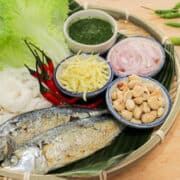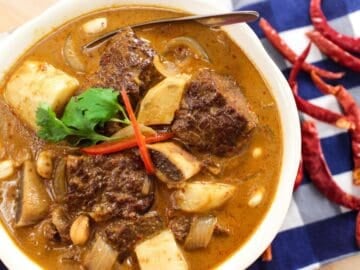Jump to video!
Hello from my mom's garden in Thailand! I waited all year to come home and make miang kham, which is potentially the most unique tasting dish I've made so far on the show! There really isn't anything quite like it. You make a little cup with the betel leaf, fill it with all sorts of goodies, and top it all with a sweet-savoury sauce. It really is an explosion of flavours and textures, and a dish you must try at least once in your life!
Want to save this recipe?
Watch The Full Video Tutorial!
All my recipes come with step-by-step video tutorials with extra tips not mentioned in the blog post, so make sure you watch the video below to ensure success - and if you enjoy the show, please consider subscribing to my YouTube channel. Thank you!

"Miang Kham" Wild Betel Leaf Wrap เมี่ยงคำ
Ingredients
Wrap Ingredients (amounts are estimated, you can put as much or as little of each ingredient as you wish)
- 20 bai chaplu or la lot leaves (wild betel leaves, see note)
- ¾ cup toasted coconut (see note)
- ½ cup roasted peanuts
- ⅓ cup dried shrimp (soak in hot water for at least 15 minutes to soften)
- 2 thin-skinned limes, diced with the skin on (see note)
- Chilies, to taste, thinly sliced
- ¼ cup shallot, small diced
- ¼ cup ginger, small diced
Notes:
Although in the video I called these "betel leaves," this was a mistake as it should be WILD betel leaves. The two are different as betel leaves are not edible in this manner. When buying, be sure to ask for "la lot" in Vietnamese or "bai chaplu" in Thai. Many stores mistakenly label these as "betel leaves" so do double check. You can also sub Chinese broccoli leaves or another earthy-tasting dark leafy green.
I show you the old school method in the video, but most of you will probably use dried coconut! If so, use the larger "flakes" rather than the finely shredded kind. Toast or bake the coconut until it turns a deep dark brown colour, not golden brown! You will need some for the sauce as well so toast a little extra!
If you're using the big limes that are commonly found in N.America, the skin will be too tough and too bitter to dice it skin-on. So, you will need to first finely grate the lime zest and set it aside, then peel off the bitter, white pith and throw it away. Now that you're left with just the sour lime flesh, use a sharp knife and cut it into small pieces, then toss the lime flesh with the zest.
Miang Kham Sauce
- 1 tablespoon dried shrimp
- 3 tablespoon chopped galangal
- 2 tablespoon chopped ginger
- ½ cup water
- 125 g palm sugar, chopped
- 1 teaspoon shrimp paste, or more if you like the flavour
- 1- 1 ½ tablespoon fish sauce
- 2 tablespoon toasted coconut, ground until mealy
- 2 tablespoon toasted peanuts, ground until mealy
Want to save this recipe?
Instructions
To make the sauce: Add dried shrimp to blender and blend until fine, then add galangal, ginger, and about half of the water and blend until fine. Pour into a small pot. Rinse blender with the remaining water to get all the bits out, then pour into pot.
Add palm sugar, shrimp paste and fish sauce to the blended herbs, then bring to a simmer until the sugar is completely dissolved. Once all the sugar has dissolved, simmer on low heat for 5 more minutes until reduced by about half. Add the ground coconut and ground peanuts. Let the sauce cool until it's lukewarm, then check the consistency to make sure it is not too thick, if it is, you can add a bit more water. If it's too runny, reduce it a bit more. Taste and adjust seasoning with more fish sauce as needed.
To eat the wrap, make a little cone with the betel leaf, then fill it with all the wrap ingredients to your liking. Top with a little bit of sauce, close the cup and eat it all in one bite!





Sylvie Parent says
These are one of my favourite so delicious and surprising l love it 🥰
I leave in Quebec in a small French town by the St- Laurence river every spring is the snow crab and shrimp season and make this recipe with those fresh seafoods and unfortunately l can’t find betel leaves or lotus flowers l use lettuce or young kale from my garden …its not the same but it still very delicious.
Merci Pailin for your wonderful recipes ☺️
Zack says
For me, this is the most incredible of all Thai dishes. A taste sensation as you say.
I concur with the comment about shrimp paste, once you add it to anything, it's all you can taste. I leave it out of all Thai dishes, including this one, for that reason. You can always add some extra fish sauce instead. I typically don't add the dried shrimp either which conveniently makes this a completely vegan dish that I can serve to anyone.
LauraLee says
I thought I had found the right leaves just called “bitter leaf” at the Asian market, but they were pretty bitter. I swapped them out with just green leaf lettuce, which is easy to roll up. My main dislike was the sauce. I thought the shrimp paste completely overpowered everything else in it. Now this was my first experience using shrimp paste, and I will say I definitely don’t care for it. Maybe there’s so many other flavors in curry paste that I don’t notice it, but I really disliked the sauce. I tried adding some tamarind sauce, but just switched over to some chili sauce eventually. Very fun dish though and I can see this being a great party dish.
Pailin Chongchitnant says
I appreciate the feedback! Shrimp paste is definitely an acquired taste if you didn't grow up with it, but i'm glad you tried!
Quin says
The peanut definitely made all the difference. Oh so good.. made the sauce ahead of time and I ate at least 1 tbsp of it. Hahaha
Chris says
I used Belgian endive leaves which worked really well.
Ruth Isaac says
A really nice recipe indeed. We love Thai food and especially the starters.
Just wanted to mention that betel leaves are edible and used in Indian cooking. I use it to make a fried rice ( it's one of the ingredients) and also when making ghee. Paan is another very popular after dinner item where various ingredients are wrapped in the betel leaf and popped into the mouth as a palate cleanser. It's a must at all Indian weddings. You just need to know how to use it.
Thanks again for a lovely recipe.
Bill E says
I was really looking forward to this dish. I have loved your recipes and followed you for a number of years now. I was able to get all the ingredients for this including the betel leaves.
One mistake I know I made was to use too much Galangal in the sauce. One area I have struggled with was when a recipe calls for 1" of ginger or some other root. Given all the differences in thicknesses of the roots I find this a bit loose for my tastes. Is there a way you could change the recipes to instead call for a specific amount in grams?
I was able to find betel leaves at my local Asian market. However, the betel leaves were intensely bitter to the point we could not eat them. Are there different betel leaves or do they become more bitter as they grow larger?
What should I have done differently?
Pailin Chongchitnant says
Hi Bill, I'm sorry this happened and thank you for your feedback. There are indeed 2 different kinds of betel leaves and these ones should technically be called "wild betel leaves. I should have been more specific and warn people of the two, but in all of the Asian markets that I have been to, they are simply labeled as "betel leaves" and I have never seen the other type for sale so I wasn't initially aware of this potential mixup. I have updated the recipe to reflect this, so thank you for bringing this to my attention.
Regarding the galangal, I have changed the recipe to be more specific, and I will get the weight when I can. Though even if you used the fatter root, at 1.5 inch it probably would still be fine, so it may be that it's not a flavour that you enjoy in this so next time I would use half the amount and see if that's better. Thanks again for your feedback!
LayChin Nicholson says
I LOVE LOVE Miang Kham!! I had the opportunity to make it for a bookclub theme luncheon. Of course, I could not find betel leaves and have to use young broccoli leaves instead. What a wonderful experience for my bookclub ladies. They were amazed with the exciting flavors!